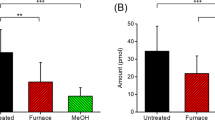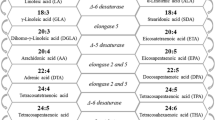Abstract
A comparative study between two methods (lipid extraction followed by saponification and methylation, and direct methylation) to determine the fatty acids in egg yolk was evaluated. Direct methylation of the samples resulted in lower fatty acid content and greater variation in the results than the lipid extraction followed by saponification and methylation. The low repeatability observed for the direct HCl methylation method was probably due to a less efficient extraction and conversion of the fatty acids into their methyl esters as compared to the same procedure starting with the lipid extract. As the lipid extraction followed by esterification method was shown to be more precise it was validated using powdered egg certified as reference material (RM 8415, NIST) and applied to samples of egg, egg enriched with polyunsaturated omega-3 fatty acids (n-3 PUFA), and commercial spray-dried whole egg powder.
Similar content being viewed by others
Abbreviations
- n-3 PUFA:
-
Polyunsaturated omega-3 fatty acids
- BF3 :
-
Methanolic boron trifluoride
- FAME:
-
Fatty acids methyl ester
- EPA:
-
Eicosapentaenoic acid
- DHA:
-
Docosahexaenoic acid
- SFA:
-
Saturated fatty acid
- RSD%:
-
Relative standard deviation
References
Eder K (1995) Gas chromatographic analysis of fatty acid methyl esters. J Chromatogr B 671:113–131
Folch J, Less M, Stanley GHS (1957) A simple method for the isolation and purification of total lipids from animal tissues. J Biol Chem 226:497–509
Metcalfe LD, Schmitz AA, Pelka JR (1966) Rapid preparation of fatty acid esters from lipids for gas chromatographic analysis. Anal Chem 38:514–515
AOAC (1997) Official methods of analysis of AOAC international. In: Arlington (ed) Association of official agricultural chemists, 16th edn. Official Method 963. 33, Gaithersburg, Maryland, USA
AOCS (1997) In: Firestone D (ed) Official methods and recommended practices of the American oil chemists’ society, 5th edn. Official Method Ce 1b-89. American Oil Chemists’ Society Press, Champaign
Ackman RG (1998) Remarks on official methods employing boron trifluoride in the preparation of methyl esters of the fatty acids of fish oils. J Am Oil Chem Soc 75:541–545
Hartman L, Lago RCA (1973) Rapid preparation of fatty acid methyl esters from lipids. Lab Prac 22:475–476
Slover HT, Lanza E (1979) Quantitative analysis of food fatty acids by capillary gas chromatography. J Am Oil Chem Soc 56:933–943
Craske JD (1993) Separation of instrumental and chemical errors in the analysis of oils by gas chromatography—a collaborative evaluation. J Am Oil Chem Soc 70:325–334
Wang Y, Sunwoo H, Cherian G, Sim JS (2000) Fatty acid determination in chicken egg yolk: a comparison of different methods. Poult Sci 79:1168–1171
Lepage G, Roy CC (1986) Direct transesterification of all classes of lipids in a one step reaction. J Lipid Res 27:114–120
Gutnikov G (1995) Fatty acid profiles of lipids samples. J Chromatogr B 671:71–89
Kramer JKG, Blackadar CB, Zhou JQ (2002) Evaluation of two GC columns (60-m SUPELCOWAX 10 and 100-m CP Sil 88) for analysis of milk fat with emphasis on CLA, 18:1, 18:2 and 18:3 isomers, and short- and long-chain FA. Lipids 37:823–835
Ratnayake WMN (2004) Overview of methods for the determinations of trans fatty acids by gas chromatography, silver-ion thin-layer chromatography, silver-ion liquid chromatography, and gas chromatography/mass spectrometry. J AOAC Int 87:523–539
Stránsky K, Jursík T, Vitek A (1997) Standard equivalent chain length values of monoenic and polyenic (methylene interrupted) fatty acids. J High Resol Chromatogr 20:143–158
Bragagnolo N, Rodriguez-Amaya DB (2001) Total lipid, cholesterol, and fatty acids of farmed freshwater prawn (Macrobrachium rosenbergii) and wild marine shrimp (Penaeus brasiliensis, Penaeus schimitti, Xiphopenaeus kroyeri). J Food Comp Anal 14:359–369
Bragagnolo N, Rodriguez-Amaya DB (2002) Simultaneous determination of total lipid, cholesterol and fatty acids in meat and back fat of suckling and adult pigs. Food Chem 79:255–260
Woollard PM, Mallet AI (1984) Lipoxygenase products—a novel gas—chromatography mass—spectrometric assay for monohydroxy fatty acids. J Chromatogr 306:1–21
Kuksis A, Myher JJ (1995) Application of tandem mass—spectrometry for the analysis of long-chain carboxylic acids. J Chromatogr B 671:35–70
Shantha NC, Ackman RG (1990) Nervonic acids versus tricosanoic acid as internal standards in quantitative gas—chromatographic analysis of fish oil longer-chain n-3 polyunsaturated fatty acid methyl esters. J Chromatogr B 533:1–10
Joseph JD, Ackman RG (1992) Capillary column gas chromatographic method for analysis of encapsulated fish oils and fish oil ethyl esters: collaborative study. J AOAC Int 75:488–506
Schreiner M (2005) Quantification of long chain polyunsaturated fatty acids by gas chromatography—evaluation of factors affecting accuracy. J Chromatogr A 1095:126–130
Ackman RG, Sipos JC (1964) Application of specific response factors in the gas chromatographic analysis of methyl esters of fatty acids with flame ionization detectors. J Am Oil Chem Soc 41:377–378
Grob K, Biedermann M (2002) The two options for sample evaporation in hot GC injectors: thermospray and band formation. Optimization of conditions and injector design. Anal Chem 74:10–16
Tande T, Breivik H, Aasoldsen T (1992) Validation of a method for gas chromatographic analysis of eicosapentaenoic acid and docosahexaenoic acid as active ingredients in medicinal products. J Am Oil Chem Soc 69:1124–1130
USDA (2000) Nutrient database for standard reference. Release 13, NDB No. 13390, No. 01125, No. 01133
Li-Chan ECY, Powrie WD, Nakai S (1995) The chemistry of eggs and egg products, in Egg Science and Technology. In: Stadelman WJ, Cotterill OJ (eds) 4th edn. Food Products Press, New York, p 591
Mazalli MR, Faria DE, Salvador D, Ito DT (2004) A comparison of the feeding value of different sources of fat for laying hens: 2. lipid, cholesterol, and vitamin E profiles of egg yolk. J Appl Poult Res 13:280–290
Kuksis A (1992) Yolk lipids. Biochem Bioph Acta 1124:205–222
Guardiola F,Codony R, Rafecas M, Boatella J, López A (1994) Fatty acid composition and nutritional value of fresh eggs, from large- and small-scale farms. J Food Comp Anal 7:171–180
Camacho ML, Méndez MVR, Constante EG (2003) Cinética de la reacción de elaidización del ácido oléico durante la desodorización y/o refinación física de las grasas comestibles. Grasas y Aceites 54:138–144
Wolff RL (1993) Heat-induced geometrical isomerization of α-linolenic acid: effect of temperature and heating time on the appearance of individual isomers. J AOCS 70:425–430
Mjos SA, Solvang M (2006) Geometrical isomerisation of eicosapentaenoic and docosahexaenoic acid at high temperatures. Eur J Lipid Sci Technol 108:589–597
Fournier V, Destaillats F, Juanéda P, Dionisi F, Lambelet P, Sébédio JL, Berdeaux O (2006) Thermal degradation of long-chain polyunsaturated fatty acids during deodorization of fish oil. Eur J Lipid Sci Technol 108:33–42
Fontana A, Antoniazzi F, Ciavatta ML, Trivellone E, Cimino G (1993) H-NMR study of cholesterol autooxidation in egg powder and cookies exposed to adverse storage. J Food Sci 58:1286–1290
Wheeler WH (1980) Chemical and engineering aspects of low NOx concentration. Chem Eng 362:693–699
Pryor WA, Lightsey JW (1981) Mechanism of nitrogen dioxide reactions: initiation of lipid peroxidation and the production of nitrous acid. Sci 214:435–437
Acknowledgments
The authors are grateful to the São Paulo State Research Foundation (FAPESP) and the Brazilian National Research Foundations (CAPES and CNPq) for their financial support.
Author information
Authors and Affiliations
Corresponding author
About this article
Cite this article
Mazalli, M.R., Bragagnolo, N. Validation of Two Methods for Fatty Acids Analysis in Eggs. Lipids 42, 483–490 (2007). https://doi.org/10.1007/s11745-007-3046-4
Received:
Accepted:
Published:
Issue Date:
DOI: https://doi.org/10.1007/s11745-007-3046-4




